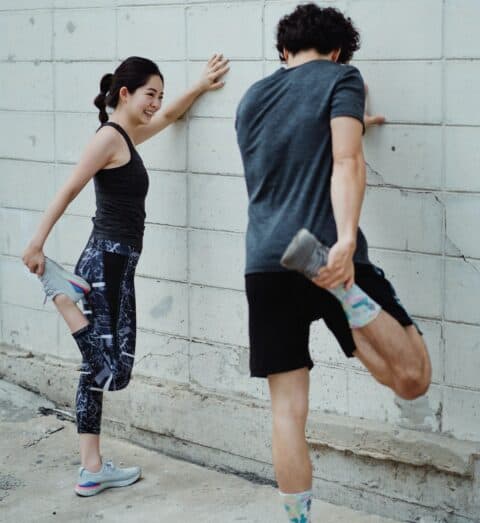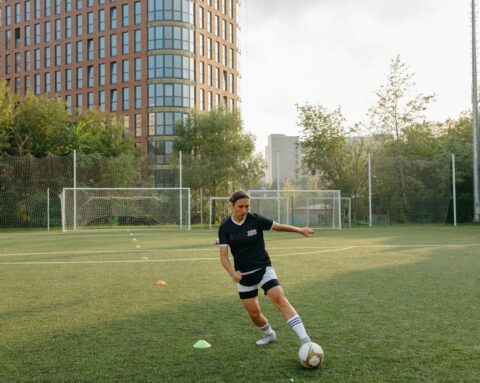When your ligaments are overstretched, an ankle sprain can occur. Over-stretching is usually due to rolling your ankle on unstable ground or whilst landing awkwardly from a jump or whilst running. In some, more extreme cases, a significant fracture or avulsion fracture can occur.
Your ankle joint is made up of three different bones and is known as the talocrural joint. ⠀
⠀
The three bones are your talus, tibia and fibular which are your deep ankle bone, shinbone and outer lower leg bone respectively. Below your ankle joint is the subtalar joint which is the connection between your heel bone and deep ankle bone. Your ankle ligaments are attached bone-to-bone and function to limit the motion of the joints. ⠀
⠀
When you have an ankle sprain the most commonly injured ligaments are the anterior talofibular ligament, the posterior talofibular ligament, posterior talofibular ligament, calcaneofibular ligament and the deltoid ligament.
Diagnosis:
To diagnose whether your ankle is sprained your myotherapist will assess the injury by performing a clinical examination and listening to your injury history.⠀
⠀
Your myotherapist is highly skilled in injury assessment and may if required, ask for additional tests such as an MRI or X-ray to correctly diagnose the extent of the injury.
Injury Outlook:
A sprained ankle can, unfortunately, increase your risk of re-injury by 40-70%. Fortunately, having an extensive post-injury rehabilitation program organised by your myotherapist will significantly lower that risk! Your essential treatment will not only help to prevent re-injury but will improve your range of motion, strength and restore your speed and agility. Once your rehabilitation is completed successfully there is no reason for you not to be able to return to gradual training and competition!
Ankle Sprain Gradings:
There are 3 different gradings for your ankle sprain that will determine your recovery outlook. If your injury is mild you can expect full ligament healing within 2-3 weeks however it may take up to 6 weeks for a full recovery. ⠀
⠀
For mild sprains, it can be important to have your ankle treated to avoid muscle weakness, joint stiffness and reduced balance. If your injury is not treated correctly it is common for your body to overcompensate and lead to injuries in surrounding muscles or joints.
If you have a significant ligament injury that caused the ligament to excessively stretch you have a grade 2 ankle sprain. Grade 2 ankle sprains usually take at least 4-6 weeks to recover and contain a more elaborate rehabilitation process to enable full proprioception, power, agility, motion and strength. If your ligament is completely ruptured you have a grade 3 strain. These strains may also include bone fractures or high ankle sprains which will require more additional rehabilitation time. ⠀
⠀
A grade 3 ankle sprain usually takes up to 12 weeks to heal but can vary greatly depending on your case. Your myotherapist will be able to provide you with more specific guidelines and advice!
Rehabilitation:
Your sprained ankle rehabilitation will progress through six stages. There is no specific amount of time for when you should be professing from one phase to the next phase. Your myotherapist will perform a clinical assessment to help determine the many factors that will guide your progression. It is crucial to allow your myotherapist to guide you through each of these stages as moving on to early can lead to re-injury.⠀
In phase one of your ankle sprain, the initial treatment will revolve around Rest, Ice, Compression and Elevation (RICE) ⠀
⠀
As you will most likely be unable to walk in the early moments of your injury it is important to be non-weight bearing and to rest the injured area. Ice should be applied for 20-30 minutes every 2 to 4 hours. A compression bandage or kinesiology taping may be applied to help support the ankle and reduce your swelling. Finally, it will be important to elevate the injured area to reduce swelling near the ankle. ⠀
⠀
Your myotherapist will employ many different tricks and techniques to personalise your treatment and ensure you have the best possible care for your unique recovery situation.
In phase 2 of the injury recovery, we will be ensuring that your ankle can return to a full range of motion. If your ankle ligaments are protected appropriately it is common for the torn ligaments to heal and reattach to their previous length. ⠀
⠀
During the first 6 weeks of recovery, it is important to optimally remould your scar tissue to prevent a poorly formed scar that could re-tear in the future. Your myotherapist will design exercises and massage techniques that will address your muscle length and joint range of motion. ⠀
⠀
It is crucial to have your myotherapist assess the amount of ankle joint motion you currently have as a history of ankle sprains can place you at risk to develop injuries in the future such as back pain or calf and leg injuries.
In phase 3 your myotherapist will guide you to help restore the strength in your ankle, calf and foot muscles. It is crucial to regain the normal strength as this will help to provide both functionality and control. ⠀
⠀
Your myotherapist will guide you to gradually progress from non-weight bearing to partial weight-bearing to full weight and resistance! In this stage, it is also normal for your treatment plan to require the strengthening of the other leg and surround muscles.
In Phase 4 and 5 of your ankle sprain rehabilitation, the treatment will focus on normalising your foot biomechanics and restoring your high speed, power, proprioception, and agility⠀
⠀
It is very common for sprained ankles to occur due to poor foot biomechanics such as having a high arch or a flat foot. Your myotherapist will assess your control and arch and you may be required to undergo a foot stabilisation program or to wear an orthotic in your shoe. ⠀
⠀
As most ankle sprains occur during high-speed activities; balance and proprioception are greatly affected when the injury occurs. Your myotherapist will assess the severity of your sprain and guide you through the exercises that will allow you to return to sport as soon as possible.
Return To Sport:
In the final phase of your ankle sprain rehabilitation, we will be ensuring that you can return to your sport of choice! This may require some more sport-specific exercises that follow a training routine to enable an injury-free return to your old activity levels. ⠀
⠀
It is crucial to set and understand your schedule, time frame and goals. Your myotherapist will discuss all of this with you so that your training program is optimised for your situation. If the rehabilitation is a complete success you should be able to perform at your maximum agility, power and speed. You will also have a lower chance of future injury provided you follow all the steps that your myotherapist outlines.
Other Possible Injuries:
If your ankle sprain includes damage to the stabilising structures of your shin bones you may have suffered a high ankle sprain. A high ankle sprain is far more debilitating and is often misdiagnosed. The truth of ankle sprain injuries is that there is rarely a simple version of an ankle sprain that does not cause an ongoing impact on your functionality. ⠀
⠀
Therefore, it is crucial for professional rehabilitation guidance by your myotherapist to accurately assess your injury and correct any defects that may not be observed by an untrained eye.
Ankle fractures are much more serious than ankle sprains and are commonly misdiagnosed. An ankle fracture occurs when there is a break in one or multiple bones. These breaks can often occur as a side effect of an ankle sprain. When a fracture occurs as a side effect of an ankle sprain it is typically less troublesome than a fracture that occurs within the ankle joint. ⠀
⠀
Any type of ankle fracture will require proper medical treatment and diagnosis to avoid having long term health problems with your ankle and feet. Your myotherapist may recommend for you to be referred to and x-ray or orthopaedic surgeon.
Final Thoughts:
Your sprained ankle will most likely heal within 6-12 weeks, however, it is important to ensure that your ankle retains all of its functionality in the long term. Your ability to swim, point your toes or walk downstairs could be hampered if you are not able to fully rehabilitate a stiff ankle. This means that your ankle should be able to regain a full range of motion. ⠀
⠀
If your ankles are loose it can make you feel unstable and far more susceptible to further damage your ankle joint. Your myotherapist can assist you to strengthen your ankles to regain dynamic control. Contact Studio Musculoskeletal today.






